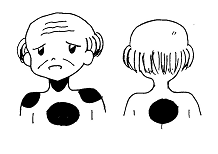Health Information
Signs of a Heart Attack
Date:2024-09-12Pingtung Branch of Kaohsiung Armed Forces General Hospital

Signs of a Heart Attack
1.What is a heart attack?
A heart attack occurs when the blood vessels supplying blood and oxygen to the heart, known as “coronary arteries,” become narrowed or blocked. This results in decrease of blood flow and oxygen supply, leading to ischemia (lack of blood flow) and hypoxia (lack of oxygen) in the heart cells. These symptoms are referred to as a heart attack. It is often triggered by cold weather, exercise, or emotional stress, causing chest pain, which may improve slightly with rest.
2.Common Symptoms
The symptoms of a heart attack are similar to those of angina, but more severe, and can occur even at rest. However, sometimes the symptoms are mild and overlooked by the patient. Therefore, when experiencing any of the following symptoms, do not ignore them regardless of their severity:
-
Sharp or severe chest pain that lasts more than 30 minutes. The pain may sometimes radiate to the jaw, shoulders, or back (as shown in the shaded area of the image).

-
Chest discomfort is often accompanied by shortness of breath, palpitations (feeling of a racing heartbeat), bulging neck veins, cold sweats, cold extremities, pale complexion, nausea, vomiting, dizziness, fatigue, indigestion, or a feeling of difficulty in breathing. In severe cases, fainting may occur.
3.Management of a Heart Attack
-
Help the patients adjust themselves into a semi-sitting position, immediately loosen restrictive clothing, and provide oxygen if available.
-
If the patient has received prior treatment, assist them in taking prescribed medications.
-
If the above symptoms are present, sublingual nitroglycerin (NTG) tablets should be administered every five minutes based on doctor’s prescription. If chest pain persists after taking three tablets, seek medical assistance as soon as possible.